Everyday Mathematics 1st Grade Answer Key Unit 4 Length and Addition Facts
Everyday Mathematics Grade 1 Home Link 4.1 Answers
Introducing Length Measurement
Family Note
Today your child began exploring length. Children directly compared the lengths of two objects. Then they compared the lengths of two objects indirectly by using a third object, such as a strip of paper or a piece of string. Ask your child to explain how to use a strip of paper to compare length.
Question 1.
List 3 things at home that are longer than the string.
Answer:
3 or Three things at home that are longer than the string are:
1. Window.
2. Dinning table.
3. Bed.
Explanation:
3 or Three things at home that are longer than the string are:
1. Window.
2. Dinning table.
3. Bed
Question 2.
List 3 things at home that are shorter than the string.
Answer:
3 things at home that are shorter than the string are:
1. Laptop.
2. Personal computer
3. Television.
Explanation:
3 things at home that are shorter than the string are:
Laptop , Personal computer , Television.
Question 3.
Is anything you listed for Problem 1 shorter than anything you listed for Problem 2? Explain.
Answer:
No, nothing I listed for Problem 1 is shorter than anything listed for Problem 2 because they length is comparatively greater.
Explanation:
No, nothing I listed for Problem 1 is shorter than anything listed for Problem 2 because they length is comparatively greater than the things I have listed for Problem 2.
Practice
Question 4.
Draw the missing dots. Fill in the sentence.

________ + 8 = 17
Answer:
9 + 8 = 17.
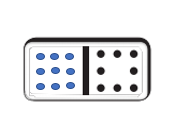
Explanation:
Sum:
Let the missing number be ??.
?? + 8 = 17
?? = 17 – 8
?? = 9 or Nine.
Everyday Math Grade 1 Home Link 4.2 Answer Key
Measuring Length
Family Note
Today your child learned that length is measured with same-size units placed end to end without gaps or overlaps. As your child completes the Home Link, check that the units are placed end to end without gaps or overlaps.
Find at least 5 of the same item. They must be the same size. For example, you might choose paper clips, blocks, or toothpicks. This will be your length unit.
Question 1.
I chose _____________ for my length unit.
Answer:
I chose ____blocks_________ for my length unit.
Explanation:
I chose blocks for my length unit.
Question 2.
Draw a line that is 1 _____________ long.
Answer:
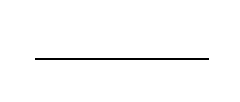
Explanation:
A line that is 1 __block___________ long I have drawn.
Question 3.
Draw a line that is 3 _____________ long.
Answer:

Explanation:
A line that is 3 __block___________ long I have drawn.
Question 4.
Draw a line that is 5 _____________ long.
Answer:

Explanation:
A line that is 5 __block___________ long I have drawn.
Practice
Question 5.
Count up to solve.
What number is 1 2 more than 43? _____________
Answer:
Number 1 more than 43 = 44 or Forty Four.
Number 2 more than 43 = 45 or Forty Five.
Explanation:
Counting up 1:
Number 1 more than 43 = 43 + 1 = 44 or Forty Four.
Counting up 2:
Number 2 more than 43 = 43 + 2 = 45 or Forty Five.
Everyday Mathematics Grade 1 Home Link 4.3 Answers
More Length Measurement
Family Note
In the last lesson, your child measured objects by lining up same-size units (such as toothpicks) end to end. Today, children explored ways to measure objects using only one unit, such as an unsharpened pencil. They practiced moving the pencil along the length of an object, avoiding gaps and overlaps, and counting the number of pencils to determine the length.

Question 1.
Trace the outline of your thumb in the box.
![]()
This is a imgg 2 thumb length unit.
Answer:

Explanation:
My Thumb outline is drawn in the box given.
Question 2.
About how many thumbs long is this pencil?

About _____________ thumbs
Answer:
3 or Three Thumbs long is this pencil.
Explanation:

3 or Three Thumbs long is this pencil.
Question 3.
About how many thumbs long is this string?
![]()
About _____________ thumbs
Answer:
5 or Five thumbs long is this string.
Explanation:

5 or Five thumbs long is this string.
Practice
Count up to solve.
Question 4.
What number is 6 more than 7?
Answer:
Number 6 more than 7 = 13 or Thirteen.
Explanation:
Counting up 6:
Number 6 more than 7 = 7 + 6 = 13 or Thirteen.
Question 5.
What number is 5 more than 9?
Answer:
Number 5 more than 9 = 14 or Fourteen.
Explanation:
Counting up 5:
Number 5 more than 9 = 9 + 5 = 14 or Fourteen.
Question 6.
What number is 8 more than 4?
Answer:
Number 8 more than 4 = 12 or Twelve.
Explanation:
Counting up 8:
Number 8 more than 4 = 8 + 4 = 12 or Twelve.
Question 7.
What number is 7 more than 9?
Answer:
Number 7 more than 9 = 16 or Sixteen.
Explanation:
Counting up 7:
Number 7 more than 9 = 9 + 7 = 16 or Sixteen.
Everyday Math Grade 1 Home Link 4.4 Answer Key
Measuring with Spoons
Family Note
Today your child discussed how to make a good measurement using nonstandard units, such as blocks. Children learned that they should line up identical units without gaps or overlaps.
Help your child line up same-size spoons end to end as you complete this Home Link.
Use spoons to find the length of each object.
Question 1.
Your bed About __________ spoons long
Answer:
My bed is About ____96______ spoons long.
Explanation:
96 or Ninety Six spoons length long is my Bed.
Question 2.
Your pillow About __________ spoons long
Answer:
My pillow is about ____3______ spoons long.
Explanation:
3 or Three spoons length long is my pillow.
Question 3.
A sofa or chair About __________ spoons long
Answer:
My Sofa is about ____21______ spoons long.
My Chair is about ____6______ spoons long.
Explanation:
21 or Twenty One spoons length long is my Sofa.
3 or Three spoons length long is my Chair.
Draw or write how you used the spoons to measure
Answer:
I started measuring the objects length placing the spoon from starting till the end of the object continuously joining it.
Explanation:
I have taken a spoon. Later I started measuring the objects length placing it from starting till the end of the object continuously joining it.
Practice
Question 4.
Ming has 5 limes and 7 oranges. How many pieces of fruit does Ming have?
__________ pieces of fruit
Number model: ____________
Answer:
Total number of fruits Ming has = 12 or Twelve.
Number model: = 5 + 7 = 12 or Twelve.
Explanation:
Number of limes Ming has = 5 or Five.
Number of oranges Ming has = 7 or Seven.
Total number of fruits Ming has = Number of limes Ming has + Number of oranges Ming has
= 5 + 7
= 12 or Twelve.
Everyday Mathematics Grade 1 Home Link 4.5 Answers
Building Shapes from Shapes
Family Note
Today your child learned that good questions for collecting data have more than one possible answer. Children also created shapes with given numbers of sides or corners. And they combined 2- and 3-dimensional shapes to make new shapes.
Question 1.
Trace these triangles onto another paper. Cut them out from that paper. Combine them to make four different shapes. Draw all four shapes you made on the back of this paper.
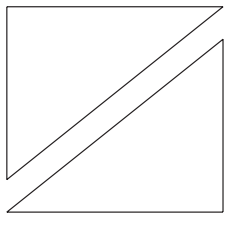
Answer:

Explanation:
Using the shapes given I have drawn these four different shapes.
Practice
Question 2.
Shana has 3 green marbles and 4 red marbles. How many marbles does Shana have in all?
__________ marbles
Number model: __________
Answer:
Total number of marbles Shana has in all = 7 or Seven.
Number model: 3 + 4 = 7 or Seven.
Explanation:
Number of green marbles Shana has = 3 or Three.
Number of red marbles Shana has = 4 or Four.
Total number of marbles Shana has in all = Number of green marbles Shana has + Number of red marbles Shana has
= 3 + 4
= 7 or Seven.
Everyday Math Grade 1 Home Link 4.6 Answer Key
Representing Data with a Bar Graph
Family Note
In previous lessons, children organized data in tally charts. Today your child learned how to use a bar graph to organize and interpret data.

Answer the questions about the bar graph.
Question 1.
How many children pick up toys before dinner?
__________ children
Answer:
5 or Five children picked up toys before dinner.
Explanation:
Number of toys picked up before dinner = 5 or Five.
Question 2.
How many children pick up toys before bedtime?
__________ children
Answer:
4 or Four children picked up toys before bedtime.
Explanation:
Number of toys picked up before bedtime = 4 or Four.
Question 3.
Did more children pick up toys after dinner or before bedtime? __________
How many more children? __________ more children
Answer:
Number of toys picked up more are before dinner = 5 or Five.
Number of children picked up more toys = 1 or One.
Explanation:
Number of toys picked up before bedtime = 4 or Four.
Number of toys picked up before dinner = 5 or Five.
Number of children picked up more toys = Number of toys picked up before dinner – Number of toys picked up before bedtime
= 5 – 4
= 1 or One.
Practice
Question 4.

Answer:

Explanation:
Counting by 2 :
Numbers are 9 , 11 , 13 , 15 , 17.
Everyday Mathematics Grade 1 Home Link 4.7 Answers
Introducing Doubles
Family Note
Today your child was introduced to doubles such as 1 + 1 = 2, 2 + 2 = 4, 3 + 3 = 6, and so on. Doubles are often some of the first addition facts that children master
Play Roll and Record Doubles with someone at home.
Directions
Question 1.
Roll a dot die. Use that number to make a double.
Answer:
Double the number = 2 + 2 = 4 or Four.
Explanation:
Roll a dot die.
Number = 2
Double the number = 2 + 2 = 4 or Four.
Question 2.
Shade the first empty box above the sum for the double
Answer:

Explanation:
Sum = 2 + 2 = 4 or Four.
Question 3.
Take turns until one column is filled.

Answer:
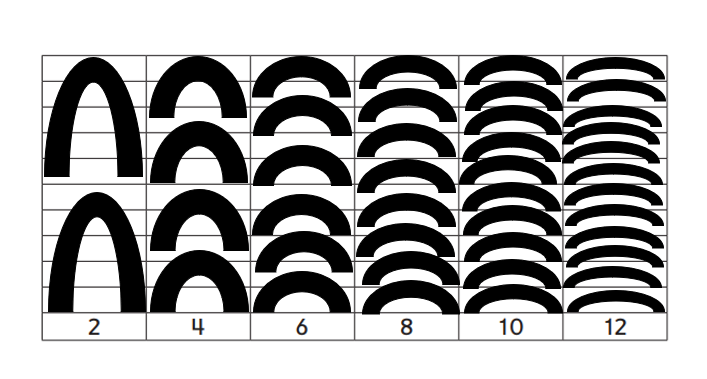
Explanation:
Number turns taken in each column are recorded in below the column.
Practice
Question 4.
Draw dots on the domino. Write a number sentence for the domino.
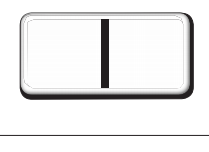
Answer:
Total number of dots in Domino = 13 or Thirteen.

Explanation:
Number of Black dots in the Domino = 8 or Eight.
Number of Blue dots in the Domino = 5 or Five.
Total number of dots in Domino = umber of Black dots in the Domino + Number of Blue dots in the Domino
= 8 + 5
= 13 or Thirteen.
Everyday Math Grade 1 Home Link 4.8 Answer Key
Combinations of 10
Family Note
Earlier in the year, your child explored pairs of numbers that add to 10. Recognizing these pairs of numbers helps with mastering many addition facts. Today your child worked with these number pairs again and categorized them formally as a group of facts known as combinations of 10.
Question 1.
Do Two-Fisted Penny Addition with someone at home:
- Make a pile of 10 pennies.
- The person at home grabs some pennies with one hand and keeps that hand closed.
- Count the pennies left in the pile and decide how many pennies are in the closed hand.
- Fill in the table. Record more on the back of this sheet.

Answer:
 Explanation:
Explanation:
Number of Pennies in the Pile + Number of Pennies in the closed hand = Number model.
Practice
Question 2.
How many pennies? Remember to include a unit.
 __________
__________
Answer:
Total number of Pennies = 6 or Six.
Cost of all pennies = $9 or Nine Dollars.
Explanation:

Number of face pennies = 3
Number of symbol pennies = 3
Total number of Pennies = Number of face pennies + Number of symbol pennies
= 3 + 2 = 6 or Six.
Cost of each face penny = $1
=> Cost of all face pennies = 3 × $1 = $3.
Cost of each symbol penny = $2
=> Cost of all symbol pennies = $2 × 3 = $ 6.
Cost of all pennies = Cost of all face pennies + Cost of all symbol pennies
= $3 + $6
= $9 or Nine Dollars.
Everyday Mathematics Grade 1 Home Link 4.9 Answers
More Combinations of 10
Family Note
Your child spent more time today working with combinations of 10. Continue working with your child to help him or her recognize combinations of 10.
Do this activity with someone at home.
Question 1.
Someone at home says a number between 0 and 10.
Answer:
Number Addition = Total number combinations – Number said by my mom
= 10 – 5 = 5 or Five.
Explanation:
Number said by my mom = 5 or Five.
Total combinations value = 10 or Ten.
Number Addition = Total number combinations – Number said by my mom
= 10 – 5
= 5 or Five.
Question 2.
You say the number that makes a combination of 10.
Answer:
Number Addition = Total number combinations – Number said by me
= 10 – 9 = 1 or One.
Explanation:
Number said by me = 9 or Nine.
Total combinations value = 10 or Ten.
Number Addition = Total number combinations – Number said by me
= 10 – 9 = 1 or One.
Question 3.
Then say the addition fact and record the number sentence in the space below.
Answer:
Addition fact = Total number combination – Number said by someone in home.
Explanation:
Addition fact = Total number combination – Number said by someone in home.
Number Addition = Total number combinations – Number said by me
= 10 – 9 = 1 or One.
Question 4.
Repeat at least 6 more times.
Answer:
Addition fact = Total number combination – Number said by someone in home.
Addition fact = Total number combination – Number said by someone in home.
Addition fact = Total number combination – Number said by someone in home.
Addition fact = Total number combination – Number said by someone in home.
Addition fact = Total number combination – Number said by someone in home.
Addition fact = Total number combination – Number said by someone in home.
Explanation:
Addition fact = Total number combination – Number said by someone in home.
Practice
Question 5.
A fish tank has 9 goldfish and 8 rainbow fish.
How many fish are in the tank? _________ fish
Write a number model.
Number model: ______________
Answer:
Total number of fishes in the fish tank = 17 or Seventeen.
Number model = Number of gold fishes in the fish tank + Number of rainbow fishes in the fish tank
= 9 + 8 = 17 or Seventeen.
Explanation:
Number of gold fishes in the fish tank = 9 or Nine.
Number of rainbow fishes in the fish tank = 8 or Eight.
Total number of fishes in the fish tank = Number of gold fishes in the fish tank + Number of rainbow fishes in the fish tank
= 9 + 8
= 17 or Seventeen.
Number model = Number of gold fishes in the fish tank + Number of rainbow fishes in the fish tank
= 9 + 8 = 17 or Seventeen.
Everyday Math Grade 1 Home Link 4.10 Answer Key
Adding Three Numbers
Family Note
Today your child learned about adding three numbers. Children learned that when more than two numbers are added, it does not matter which pair of numbers is added first.
Solve. Then answer the questions.
4 + 2 + 8 = _________
Question 1.
Which numbers did you add first?
Answer:
Numbers first added are 4 and 2.
=> 4 + 2 + 8
=> 6 + 8.
Explanation:
4 + 2 + 8 = _________.
Numbers first added are 4 and 2.
=> 4 + 2 + 8
=> 6 + 8
=> 14 or Fourteen.
Question 2.
Why did you add three first?
3 + 7 + 7 = _________
Answer:
Number Three is first added because its the given first in the Equation.
=> 3 + 7 + 7
=> 17 or Seventeen.
Explanation:
3 + 7 + 7 = _________.
Number Three is first added because its the given first in the Equation.
=> 3 + 7 + 7
=> 10 + 7
=> 17 or Seventeen.
Question 3.
Which numbers did you add first?
Answer:
First two digits are added first and later the other one.
Explanation:
First two numbers are added first and later the other one because these numbers are given first in the equation.
Question 4.
Why did you add these first?
Answer:
I have added these two numbers first because these numbers are given first in the equation.
Explanation:
I have added these two numbers first because these numbers are given first in the equation.
Question 5.
What other way could you add them?
Answer:
The other way to add them is first add higher number to other higher number in the equation.
Explanation:
The other way to add them is first add higher number to other higher number in the equation I used to add first and later the other one.
Practice
Question 6.
Solve.

Start at 7. Count up 4 hops. Where do you land? _________
Start at 5. Count up 5 hops. Where do you land? _________
Answer:

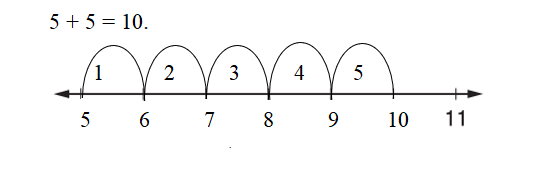
Explanation:
Starting at 7. Counting up 4 hops.

Starting at 5. Counting up 5 hops.

Everyday Mathematics Grade 1 Home Link 4.11 Answers
10 More, 10 Less
Family Note
Today your child began exploring ways to find 10 more or 10 less using a number grid. By the end of the year, children should be able to find 10 more or 10 less than a number in their heads. They will continue to practice throughout the year.

Solve.
Question 1.
What number is 10 more than 23?
Answer:
33 or Thirty Three is the number 10 more than 23.
Explanation:
Number 10 more than 23 = 23 + 10 = 33 or Thirty three.

Question 2.
What number is 10 less than 23?
Answer:
13 or Thirteen is the number 10 less than 23.
Explanation:
Difference:
Number is 10 less than 23 = 23 – 10 = 13 or Thirteen.
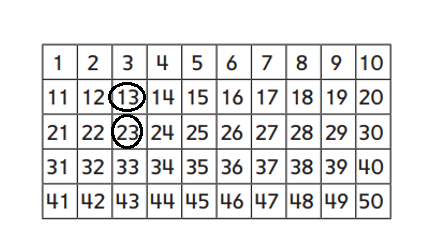
Question 3.
What number is 10 more than 38?
Answer:
48 or Fourth Eight is the number 10 more than 38.
Explanation:
Addition:
Number is 10 more than 38 = 38 + 10 = 48 or Fourth Eight.
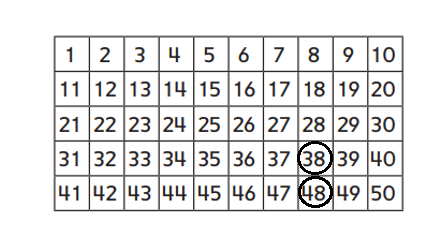
Question 4.
What number is 10 less than 38?
Answer:
28 or Twenty Eight is the number 10 less than 38.
Explanation:
Difference:
Number is 10 less than 38 = 38 – 10 = 28 or Twenty Eight.

Practice
Question 5.
April has 8 crayons. José has 4 crayons. How many crayons do April and José have in all? Write a number model.
__________ crayons
Number model: __________
Answer:
Total number of crayons both have in all = 12 or Twelve.
Explanation:
Number of crayons April has = 8 or Eight.
Number of crayons Jose has =4 or Four.
Total number of crayons both have in all = Number of crayons April has + Number of crayons Jose has
= 8 + 4
= 12 or Twelve.